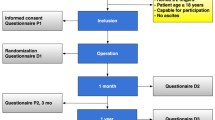Abstract
Background
Umbilical and epigastric hernias have historically been repaired without mesh resulting in recurrence rates in some series of up to 40%. Recent data suggests mesh repair of these hernias may decrease recurrent hernia rates. Ideal placement of the mesh is behind the defect, which is difficult to do without a large incision in these hernias unless done laparoscopically. The Ventralex hernia patch is a composite PTFE/polypropylene patch allowing intraperitoneal placement behind the hernia defect through a small incision, and without the cost of laparoscopy. To date, only one study exists evaluating this new prosthesis.
Methods
This study is a retrospective chart review of all umbilical and epigastric hernias repaired with the Ventralex hernia patch by a single surgeon. Patient characteristics and operative and post-operative data were collected. Hernia recurrence is the primary outcome. Secondary outcomes include complication rates.
Results
Eighty-eight patients from 2003–2006 were evaluated. The population included patients aged 25–86 (mean 52) with nineteen females (22%). The average BMI was 32 (range 18–68). Eighteen patients were smokers, five patients were diabetic, and two patients were chronic steroid users. The size of patches used were small (72%), medium (27%), and unknown (1%). Average operating room time was 52 min (range 19–194). The different types of hernias repaired were umbilical (68%), epigastric (30%), and incisional (2%). Follow-up visits ranged from 8 days to 3.1 years in all but five patients (6%). No hernia recurrences were found in follow-up. Complications included two patients (2.2%) with mesh infection requiring removal of the patch, one patient with post-operative urinary retention, and seroma formation in another patient.
Conclusions
The composite PTFE/polypropylene hernia patch is effective in preventing hernia recurrence in umbilical, epigastric, and small ventral hernia repairs and can be accomplished with a low rate of complications.




Similar content being viewed by others
References
Hessellink VJ, Luijendijk RW, de Wilt JH, Heide R, Jeekel J (1993) An evaluation of risk factors in incisional hernia recurrence. Surg Gynecol Obstet 176:228–234
Arroyo A, Garcia P, Perez F, Andreu J, Candela F, Calpena R (2001) Randomized clinical trial comparing suture and mesh repair of umbilical hernia in adults. Br J Surg 88:1321–1323
Bendavid R (2001) Abdominal wall hernias: principles and management. Springer-Verlag, New York, pp 376
Hadi HI, Maw A, Sarmah S, Kumar P (2006) Intraperitoneal tension-free repair of small midline ventral abdominal wall hernias with a Ventralex hernia patch: initial experience in 51 patients. Hernia 10:409–413
Burger JW, Luidendijk RW, Hop WC, Halm JA, Verdaasdonk EG, Jeekel J (2004) Long-term follow-up of a randomized controlled trial of suture versus mesh repair of incisional hernia. Ann Surg 240:578–585
Acknowledgments
Data collection was in part sponsored by the Bard Company (Davol Inc, Subsidiary of C.R. Bard, Inc., RI, USA).
Author information
Authors and Affiliations
Corresponding author
Rights and permissions
About this article
Cite this article
Martin, D.F., Williams, R.F., Mulrooney, T. et al. Ventralex mesh in umbilical/epigastric hernia repairs: clinical outcomes and complications. Hernia 12, 379–383 (2008). https://doi.org/10.1007/s10029-008-0351-7
Received:
Accepted:
Published:
Issue Date:
DOI: https://doi.org/10.1007/s10029-008-0351-7




